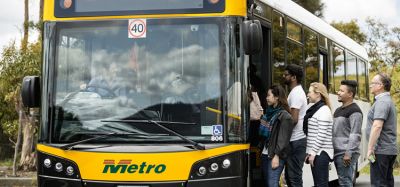Teaming up to break through interoperability barriers
- Like
- Digg
- Del
- Tumblr
- VKontakte
- Buffer
- Love This
- Odnoklassniki
- Meneame
- Blogger
- Amazon
- Yahoo Mail
- Gmail
- AOL
- Newsvine
- HackerNews
- Evernote
- MySpace
- Mail.ru
- Viadeo
- Line
- Comments
- Yummly
- SMS
- Viber
- Telegram
- Subscribe
- Skype
- Facebook Messenger
- Kakao
- LiveJournal
- Yammer
- Edgar
- Fintel
- Mix
- Instapaper
- Copy Link
Posted: 10 December 2014 | Johan van Ieperen - UITP, John Verity - ITSO Limited | No comments yet
Two years after signing their Memorandum of Understanding, the five founder members of the Smart Ticketing Alliance1 (STA) formally launched the Alliance in Brussels in June 2014 to a wider audience of transport operators and industry players. The transport smartcard operators from 10 countries came together at UITP’s head office to express their support for joining with the founders and putting the STA onto a formal legal footing. Johan van Ieperen, Manager of IT Solutions for Public Transport at the International Association of Public Transport (UITP) and John Verity, Chief Advisor at ITSO Limited and Chair of the Smart Ticketing Alliance, provide joint thoughts on how this move will lead the way towards a single transport specification for user media like NFC phones across Europe and cross-border acceptance facilitating the uptake of NFC devices.


Spurred on by endorsement from the EU’s previous Transport Commissioner, Siim Kallas, the STA has been busy setting up working groups looking at the contactless interface, NFC, certification and media security. An initiative of the Calypso Networks Association, AFIMB (France), ITSO (UK), VDV (Germany) and UITP, the STA represents a platform for cooperation and a coordinated approach for establishing ticketing interoperability for the public transport sector.
Smarter travel
Rather than looking at a journey as a series of disparate parts, ‘smarter travel’ means joining up the different elements of a journey a passenger wants to make. We start this process by giving the customer the information necessary to plan their itinerary from door-to-door.
Their journey goes from A to B and may cover many different modes of transport: walking, cycling, taxi, bus, tram, metro, local, regional, national and international trains, ferry and even air travel. We are already well on the way to sharing the level of information necessary for our customers to plan that entire journey; thanks to Open Data, for example, third party developers have created numerous successful journey planner applications.
The STA, however, works from the other extreme: providing the permission to undertake that journey (booking the travel entitlements: the tickets)! Interoperable ticketing requires working towards specifications to put all those permissions inside and alongside each other within an electronic ticketing wallet. Alternatively, the customer could download the different necessary local applications on their preferred medium and buy the ticket of choice directly from the local operator.
It does not matter whether that wallet contains real tickets or just a token which refers to a back office where the data necessary to identify you during that journey is stored. It can be pay-to-go, or a post-paid system, or even free-of-charge (i.e. concessionary fares – even if you do not have to pay a cent, you still have to be able to prove that you can travel for free).
When travel information, journey planning and ticketing come together, the loop can be closed. We can actually start to redefine journeys based on real-time information when there are service disruptions, for example, or considering your current position in the city. The customer could then receive a new itinerary and new permissions to travel using available alternatives.
The challenges to seamless mobility
‘Smart Travel’ is about seamless mobility, removing barriers even if a particular leg of a journey does not cost anything, such as walking. ‘Smart Travel’ must cover all the elements (connections, itineraries, ticketing, and payment) from door-to-door (the first mile, last mile) for all modes and across all borders.
However, we must recognise that there can be no ‘one size fits all’ approach: a balance between subsidiarity and interoperability needs to be found. We are not always going to be able to provide one ticket that covers the entire journey. We will have to accept local solutions which are only applicable in that certain area. This requires a bottom-up approach as opposed to top-down.
Moreover, we need open architecture and specifications for the way in which we will hold the permissions to travel. We already have Open Data in terms of journey planning (timetables, stop/station/facility locations and accessibility, lift and escalator status, etc.) but we also have to look at ticketing in the same way. Here we also have inter-/multi-/co-modal, cross-border, multi-operated journeys and all of those tickets can reside in their own native applications or in that same single wallet which then covers the whole of the customer’s journey – unlike the situation today, where customers are faced with dealing with various different formats, sizes and shapes of ticket, some of which are only available locally for cash. We have to be open and have a single specification for all of that.
Integration and interoperability
In addition to the above, smart ticketing will have to include: point-to-point tickets; period passes; concessionary travel; pay-on-entry and pay-as-you-go; as well as complex specialised ticketing requirements (e.g. Apex, reservations, venue entry). The Smart Ticketing Alliance is looking at the specifications and underlying requirements that are there in order to encourage integrated travel.
The results from the EU’s Interoperable Fare Management project (IFM) four years ago found that public transport needs interoperability at three levels: local schemes (to move within a city, within a region); national schemes (within a state or a country); and international schemes (especially where there are employment, recreational or other reasons for cross-border travel between countries).
We are not talking about having to use the same tickets everywhere to cover the entirety of such journeys, but individual tickets need to be interoperable so that they can all be held in the same place. To avoid any misunderstanding: the type or price of the interoperable tickets is not subject to standardisation – only the way we handle them!
The EU IFM project has now moved forward into the Smart Ticketing Alliance, which is going to provide a number ‘deliverables’ required for the wider smarter travel environment.
Firstly, seamless integration between journey planning, retailing, ticketing and real-time information using the traveller’s preferred media (e.g. a bank card or their mobile phone). The standards and specifications must be open enough to cover all of those media’s requirements.
Secondly, we must be able to link to a ‘one-stop’ smart access to planning and purchasing public transport (e.g. a web portal) which in turn is linked with wider entitlements (e.g. concessionary travel, integrated student cards etc.) or event management, fulfilling the need for wider integration. Thirdly, where payment does take place, it has to co-reside in a comparable parallel way. Only about 30% of the journeys across Europe today actually involve payment at the point of taking that journey!
The STA has numerous different goals. Firstly, it seeks to foster cooperation between national and regional smart ticketing schemes to establish interoperable smart ticketing in Europe and wider afield as well. Secondly, to develop, agree and publish the functional and technical requirements for smart ticketing interoperability. Thirdly, the STA will cooperate with other European and international bodies to promote interoperability in smart ticketing and for the establishment of trust schemes, specifications and ticketing operability.
We also need to consider security. Increasingly the customer will want to use their own smart medium (e.g. a mobile phone or tablet) and we need to be able to trust and handle those media. At the same time, the customers are only going to use smart cards if they trust them to hold their tickets securely, particularly when they have a high value – some annual UK rail tickets can cost in excess of £5,000 (€6,400). This is even a challenge for mobile network operators who tend to think in phone calls costing in the area of Euros or even tens of Euros but not thousands of Euros. The STA works closely together with CEN (European Committee for Standardisation), GSMA (the association of all mobile network operators), the NFC Forum (handset manufacturers), the UIC (International Union of Railways) and Unife (the European Rail Industry), as well as others, to agree common specifications.
Considering the opportunities
Open standards, specifications and certification offer the public transport sector a unique opportunity: to create ticketing interoperability between different schemes, based around commonly available smart media. Open standards will allow public transport operators and authorities to benefit from economies of scale in product development, procurement and speed of implementation, freeing-up valuable resources for other activities.
There are also opportunities for smart ticketing in the wider environment. Door-to-door travel integration as well as seamless integration between journey planning, retailing, ticketing and real-time information is a real possibility. Full integration between bus, tram, metro, ferry and rail is also on the agenda: making multi-modal/multi-operator journeys really happen. Enhanced modal ‘switching’ fits into the wider agenda of making transport greener and can also include integration with car and bike hire schemes. Smart ticketing also offers the prospect for one smart access to both public transport and wider privileges, not only in terms of concessionary fares or social entitlements but also in terms of retail, venue and event integration with public transport.
Conclusion
It has taken some time for the Interoperable Fare Management solution to crystallise but, with the Smart Ticketing Alliance, the public transport sector now has a single point of reference which is already recognised as the indispensable partner for any initiative dealing with electronic ticketing interoperability in public transport.
Reference
Biography




Related topics
Multimodality, Ticketing & Payments
Issue
Issue 6 2014
Related organisations
ITSO Limited, UITP
Related people
Johan van Ieperen, John Verity








